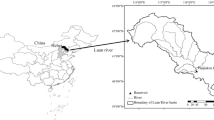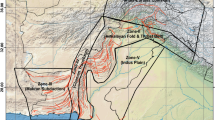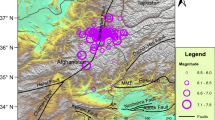Abstract
Earthquake or tsunami is a disaster that could bring massive life damages and economic loss. Although various studies on forecasting the earthquake have been conducted, the Gutenberg-Richter equation is generally used in practice. In this study, a practical method using statistical frequency analysis was suggested to estimate extreme magnitude of tsunamigenic earthquake. The study employed Bayesian approach to take into account uncertainty of earthquake occurrence corresponding to specific return periods, and mixed distribution functions to incorporate the effect of intermittent occurrence of earthquake into frequency analysis. This study utilized tsunamigenic earthquake data acquired from NOAA (National Oceanic and Atmospheric Administration), for Kamchatka and Kuril Island, Japan within Kamchatka-Kuril-Japan Trench. Using the Metropolis Hasting Markov Chain Monte Carlo (MH-MCMC) sampling, the parameters were estimated for the tsunamigenic earthquake data. Considering the uncertainty of parameters, 95% credible intervals were constructed for various return periods. This study quantified the uncertainty of possibility of earthquake occurrence so that it could be utilized as basic reference for earthquake risk analysis.
Similar content being viewed by others
References
Alves, I. F. and Neves, C. (2011). “Extreme value distributions.” International Encyclopedia of Statistical Science, pp. 493–496, DOI: 10.1007/springerreference_205330.
Benjamin, J. R. (1970). Probability, statistics, and decision for civil engineers, McGraw-Hill, New York.
Brooks, S. P. and Gelman, A. (1998) “General methods for monitoring convergence of iterative simulations.” Journal of Computational and Graphical Statistics, Vol. 7, No. 4, pp. 434–455, DOI: 10.1080/10618600.1998.10474787.
Byrdina, S, Shebalin, P., Narteu, C., and Le Moüel, J. L. (2006) “Temporal properties of seismicity and largest earthquakes in SE Carpathians.” Nonlinear Processes in Geophysics, Vol. 1, No. 6, pp. 629–639, DOI: 10.5194/npg-13-629-2006.
Campbell, K. W. (1982). “Bayesian analysis of extreme earthquake occurrences. Part I. Probabilistic hazard model.” Bulletin of the Seismological Society of America, Vol. 72, No. 5, pp. 1689–1705.
Chib, S. and Greenberg, E. (1995). “Understanding the metropolishastings algorithm.” The American Statistician, Vol. 49, No. 4, pp.327–335, DOI: 10.2307/2684568.
Chung, E. S. and Kim, S. U. (2013). “Bayesian rainfall frequency analysis with extreme value using the informative prior distribution.” KSCE Journal of Civil Engineering, KSCE, Vol. 17, No. 6, pp. 1502–1514, DOI: 10.1007/s12205-013-0189-0.
Coles, S. (2001). An introduction to statistical modeling of extreme values, Springer Series in Statistics, London, DOI: 10.1007/978-1-4471-3675-0.
Coles, S. and Pericchi, L. (2003). “Anticipating catastrophes through extreme value modelling.” Journal of the Royal Statistical Society: Series C (Applied Statistics), Vol. 52 No. 4, pp. 405–416, DOI: 10.1111/1467-9876.00413.
Congdon, P. (2007). Bayesian statistical modelling, John Wiley & Son, New York
Cornell, C. A. (1968). “Engineering seismic risk analysis.” Bulletin of the Seismological Society of America, Vol. 58. No. 5, pp. 1583–1606.
Downes, G. L. and Stirling, M. W. (2001). “Groundwork for development of a probabilistic tsunami hazard model for New Zealand.” International Tsunami Symposium 2001 Proceedings, pp. 7–10.
Galanis, O. C., Tsapanos, T. M., Papadopoulos, G. A., and Kiratzi, A. A. (2002). “Bayesian extreme values distribution for seismicity parameters assessment in South America.” Journal of the Balkan Geophysical Society, Vol. 5, No. 3, pp. 77–86.
Gutenberg, B. and Richter, C. F. (1941). “Seismicity of the Earth.” Geological Society of America Special Papers, Vol. 34, pp. 1–131, DOI: 10.1130/spe34-p1.
Gutenberg, B. and Richter, C. F. (1944). “Frequency of earthquakes in California.” Bulletin of the Seismological Society of America, Vol. 34, pp. 185–188.
Hastings, W. K. (1970). “Monte Carlo sampling methods using Markov chains and their applications.” Biometrika, Vol. 57, No. 1, pp. 97–109, DOI: 10.1093/biomet/57.1.97.
Holschneider, M., Zöller, G., and Hainzl, S. (2011). “Estimation of the maximum possible magnitude in the framework of a doubly truncated Gutenberg-Richter model.” Bulletin of the Seismological Society of America, Vol. 101, No. 4, pp. 1649–1659.
Kagan, Y. Y. (1997). “Seismic moment-frequency relation for shallow earthquakes: Regional comparison.” Journal of Geophysical Research: Solid Earth (1978–2012), Vol. 102, No. B2, pp. 2835–2852, DOI: 10.1029/96jb03386.
Kagan, Y. Y. and Jackson, D. D. (2000). “Probabilistic forecasting of earthquakes.” Geophysical Journal International, Vol. 143, No. 2, pp. 438–453.
Kagan, Y. Y. and Knopoff, L. (1984). “A stochastic model of earthquake occurrence.” Proceedings of the 8th International Conference on Earthquake Engineering, Vol. 1, pp. 295–302.
Kedem, B., Chiu, L., and Karni, Z. (1990). “An analysis of the threshold method for measuring area-average rainfall.” Journal of Applied Meteorology, Vol. 29, No. 1, pp. 3–20, DOI: 10.1175/1520-0450(1990)029<0003:aaottm>2.0.co;2.
Kulikov, E. A., Rabinovich, A. B., and Thomson, R. E. (2005). “Estimation of tsunami risk for the coasts of Peru and northern Chile.” Natural Hazards, Vol. 35, No. 2, pp. 185–209, DOI: 10.1007/s11069-004-4809-3.
Metropolis, N., Rosenbluth, A. W., Rosenbluth, M. N., Teller, A. H., and Teller, E. (1953). “Equation of state calculations by fast computing machines.” The Journal of Chemical Physics, Vol. 21, No. 6, pp. 1087–1092, DOI: 10.1063/1.1699114.
Nordquist, J. M. (1945) “Theory of largest values applied to earthquake magnitudes. Transactions.” American Geophysical Union, Vol. 26, No. 1, pp. 29–31, DOI: 10.1029/tr026i001p00029.
O’Connell, D. R., Ostenaa, D. A., Levish, D. R., and Klinger, R. E. (2002). “Bayesian flood frequency analysis with paleohydrologic bound data.” Water Resources Research, Vol. 38, No. 5, pp. 16-1-16-3, DOI: 10.1029/2000wr000028.
Parsons, T., Console, R., Falcone G., Murru, M., and Yamashina, K. I. (2012). “Comparison of characteristic and Gutenberg-Richter models for time-dependent M7.9 earthquake probability in the Nankai-Tokai subduction zone, Japan.” Geophysical Journal International, Vol. 190, No. 3, pp.1673–1688, DOI: 10.1111/j.1365-246x.2012.05595.x.
Parvez, I. A. (2007). “On the Bayesian analysis of the earthquake hazard in the North-East Indian peninsula.” Natural Hazards, Vol. 40, No. 2, pp. 397–412, DOI: 10.1007/s11069-006-9002-4.
Reis, J. D. S. and Stedinger, J. R. (2005). “Bayesian MCMC flood frequency analysis with historical information.” Journal of Hydrology, Vol. 313, No. 1, pp. 97–116, DOI: 10.1016/j.jhydrol.2005.02.028.
Shevchenko, G.V., Zolotukhin, D. E., and Tikhonov, I. N. (2013). “A method for the estimation of tsunami risk along Russia’s far east.” Journal of Tsunami Society International, Vol. 32, No. 4, pp. 212–220.
Silbergleit, V. and Prezzi, C. (2012). “Statistics of major Chilean earthquakes recurrence.” Natural Hazards, Vol. 62, No. 2, pp. 445–458, DOI: 10.1007/s11069-012-0086-8.
Singh, C., Singh, A., and Chadha, R. K. (2009). “Fractal and b-value mapping in Eastern Himalaya and Southern Tibet.” Bulletin of the Seismological Society of America, Vol. 99, No. 6, pp. 3529–3533, DOI: 10.1785/0120090041.
Sornette, D., Knopoff, L., Kagan, Y. Y., and Vanneste, C. (1996). “Rankordering statistics of extreme events: Application to the distribution of large earthquakes.” Journal of Geophysical Research: Solid Earth (1978–2012), Vol. 101, No. B6, pp. 13883–13893, DOI: 10.1029/96jb00177.
Triep, E. G., and Sykes, L. R. (1997). “Frequency of occurrence of moderate to great earthquakes in intracontinental regions: Implications for changes in stress, earthquake prediction, and hazards assessments.” Journal of Geophysical Research: Solid Earth (1978–2012), Vol. 102, No. B5, pp. 9923–9948, DOI: 10.1029/96jb03900.
Tsapanos, T. M., Bayrak, Y., Cinar, H., Koravos, G. C., Bayrak, E., Kalogirou, E. E., Taspanou, A. V., and Vougiouka, G. E. (2014). “Analysis of largest earthquakes in Turkey and its vicinity by application of the Gumbel III distribution.” Acta Geophysica, Vol. 62, No. 1, pp. 59–82, DOI: 10.2478/s11600-013-0155-8.
Utsu, T. (1999) “Representation and analysis of the earthquake size distribution: a historical review and some new approaches.” Seismicity Patterns, their Statistical Significance and Physical Meaning, pp. 509–535, DOI: 10.1007/978-3-0348-8677-2_15.
Viglione, A., Merz, R., Salinas, J. L., and Blöschl, G. (2013). “Flood frequency hydrology: 3. A Bayesian analysis.” Water Resources Research, Vol. 49, No. 2, pp. 675–692, DOI: 10.1029/2011wr010782.
Yadav, R. B. S., Tsapanos, T. M., Bayrak, Y., and Koravos, G. C. (2013). “Probabilistic appraisal of earthquake hazard parameters deduced from a Bayesian approach in the northwest frontier of the Himalayas.” Pure and Applied Geophysics, Vol. 170, No. 3, pp. 283–297, DOI: 10.1007/s00024-012-0488-2.
Yoo, C., Jung, K. S., and Kim, T. W. (2005). “Rainfall frequency analysis using a mixed Gamma distribution: evaluation of the global warming effect on daily rainfall.” Hydrological Processes, Vol. 19, No. 19, pp. 3851–3861, DOI: 10.1002/hyp.6178.
Yoo, C., Kim, K., Kim, H. S., and Park, M. J. (2007). “Estimation of areal reduction factors using a mixed gamma distribution.” Journal of Hydrology, Vol. 335, Nos. 3–4, pp. 271–284, DOI: 10.1016/j.jhydrol.2006.11.026.
Zimbidis, A. A., Frangos, N. E. and Pantelous, A. A. (2007). “Modeling earthquake risk via extreme value theory and pricing the respective catastrophe bonds.” ASTIN Bulletin, Vol. 37, No. 1, pp. 163–184, DOI: 10.2143/ast.37.1.2020804.
Author information
Authors and Affiliations
Corresponding author
Rights and permissions
About this article
Cite this article
Shin, J.Y., Chen, S. & Kim, TW. Application of Bayesian Markov Chain Monte Carlo method with mixed gumbel distribution to estimate extreme magnitude of tsunamigenic earthquake. KSCE J Civ Eng 19, 366–375 (2015). https://doi.org/10.1007/s12205-015-0430-0
Received:
Revised:
Accepted:
Published:
Issue Date:
DOI: https://doi.org/10.1007/s12205-015-0430-0




